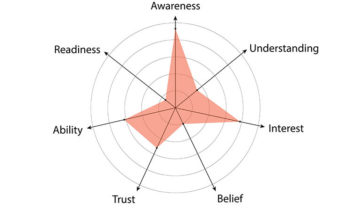The Seven Elements of Business Development

You must satisfy the seven elements of business development before your prospective client will be ready to buy.
1 | Awareness — Have they heard of you?
If clients are not aware of your firm, you can neither scope nor engage with them. The branding work done by our marketing colleagues is useful here. In the whitespace of corporate need, it is helpful to be known as an option. Think websites, social media, and airport signage. Being known in advance, of course, is not a necessity. Sometimes awareness first comes when you send an email or introduce yourself over the phone.
2 | Understanding — Do they know what you do?
Potential clients need to have an understanding of your capabilities. This is not a trivial point in a world where many firms offer a wide range of capacity. We often ask firms “What are you selling?” only to have them offer up a slurry of undigested professional services pap. Here is the rule: Specificity attracts. For example, “We sift through retail register data and are able to pinpoint which customers and which offers will help you optimize your marketing spend” is more compelling than “We drive digital transformation and strategy in a full range of industries across the globe.” Boil down what you offer to no more than a handful of value propositions where you have a) some form of competitive advantage, b) a data-rich track record of success and c) a statement that is easily understood by a parent or a neighbor. This is your elevator pitch and is the definition of your niche.
3 | Interest — Do they have a problem for which you have an answer?
In order to sell consulting services, your client must have a felt need, an interest. At least they should be open to the idea of improvement. Create distinctions which illuminate challenges or opportunities to which you are the answer. This is why practice leads write thought leadership, speak at conferences and more generally work to articulate the kind of “burning platforms” on which urgency and engagement are built. “Did you hear they changed Regulation 8b?” you whisper to a potential client. “We are seeing a variety of responses. How is your company prepared to act?”
4 | Belief — Do they think you can do the job?
Potential clients might know you, know you are active in a vertical and have a problem they need to solve, but they need to have a belief that you can do the work effectively. The secret to creating “Belief” is to clearly describe the promise of your service (“we lower costs,” “we drive revenues,” “we position you for future success”), while at the same time highlighting your track record of doing “the same thing for companies in your similar situation.” Think case studies and references.
How Do You Stack Up Compared to Your Professional Services Peers?
5 | Trust — Do they trust you?
For professional services business development, reputation is the Holy Grail. When you hear, “I’ve worked with her before; she’s a solid player,” you know someone is about to ink a new engagement. Here is the formula for creating trust: (Your effectiveness) x (Your “fit” with the client) x (The amount of time you have known the client) = trust. If you are super-smart and have been calling on a client for five years, you will not win an engagement if the client feels “she just doesn’t get us.” Ask yourself, “How can I demonstrate value to a potential client in advance of the sale, provide evidence of my fit with the buyer, and do this repeatedly over a long period of time?” Working shoulder-to-shoulder with executives builds trust, but so does staying continuously connected over time, so long as you add value when you do. This is why people travel, offer free audits, and distribute research. Abuse this imperative to repeatedly connected, however, and you risk being thought of as human spam.
6 | Ability — Does your target have the ability to pull the trigger?
Is the company (or division or unit) big enough to afford you? Are you talking to a decision-maker? This is not about pining after those hard-to-get CFO appointments; it is about being thoughtful about where the preponderance of decision-making lies. Here is a clue: It is generally not the CEO and often not in the C-suite at all. Yes, your partner went to prep school with a CEO and that resulted in a new engagement, but mostly, you are selling to the “head of retail operations” or the “director of compliance.” These are the problem solvers in an organization. Seek to be in front of the right level — not too low, but not too high, either. Target those with budget, authority and for whom your services move the needle on their objectives. Understand their mandates and responsibilities. Do your homework. What does the world look like from their perspective, not yours? Care enough to walk a mile in their shoes.
7 | Readiness — Is the timing right?
Often you have convinced the decision-maker but for reasons beyond their control, she cannot make it happen. Be patient. You are selling to large organizations with their own idiosyncratic biorhythms, including planning and budget cycles and the Byzantine politics of who is on the rise and who’s not. Be attuned to timing, and never write off a potential client. No one ever needs a consultant, until they do, and then, when they do, it is the professional who has invested in a relationship and who is most proximate to the opportunity who wins the day. Stay in touch.




